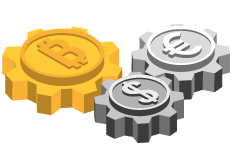
If you’re like many people today, you’ve probably heard quite a bit about Bitcoin. It’s one of the biggest cryptocurrencies available today, and many people are choosing to invest in this digital asset over other physical assets they may have otherwise selected. If you’re interested in becoming part of the thousands who are fascinated by Bitcoin and want to diversify their portfolios to include cryptocurrency, it may help to know exactly what you’re getting into and how to even begin that process. Fortunately, this quick guide can help you get there. Let’s start with a basic understanding of the idea behind cryptocurrency.
What is cryptocurrency?

Cryptocurrency is really an asset in digital form. Think of it like digital money. There’s nothing physical there, but you can exchange your digital money for goods or services. All of the records about the digital money get stored in a database that is secured through encryption. Inside that database is the record of that digital money being created and the records of every time it changes hands.
While most physical currency is issued by a government or another entity, cryptocurrency doesn’t work that way. Instead, it’s decentralised, or controlled by a number of different computers that actually make up the ledger that keeps track of the currency. This is called blockchain, and it’s a public way to track the cryptocurrency.
What is Bitcoin?

Bitcoin is just one type of cryptocurrency. Initially invented in 2008, it wasn’t actually used until 2009. There’s something of a mystery behind the individual or individuals who created. The name behind it is Satoshi Nakamoto, but no one knows exactly who that is.
It’s important to note that there are other cryptocurrencies out there, and the number of available cryptocurrencies is growing exponentially. While Bitcoin is the most popular, you may hear other names like Ethereum and Litecoin. Once you know a bit about Bitcoin and how it works, you’re likely to better understand these cryptocurrencies as well, as many of them perform in a fairly similar manner to Bitcoin, though each has an attraction designed for different kinds of investors.
First, Some Basics . . .
It’s important to understand that Bitcoin is very new in the world of currency. It allows people to nearly instantly transfer value to anyone, anywhere on the Internet, for free. Bitcoin allows buying of goods and services online, as well as transferring money. It’s wholly digital, and no one person or government controls it, so the value can vary. Unfortunately, that comes with some consequences. If you’re investing, you may have quite a bit in cryptocurrency assets one day and very little the next. The other real problem is that it’s not physical, so it’s easy to lose. If, for example, the file that holds your Bitcoin is corrupted, you lose access to the data behind your Bitcoin. Those Bitcoins are just lost, and there’s no real way to recover them. They remain part of the ledger, but don’t really have a home. Knowing the limitations of an investment like this is key to protecting yourself as you get started.
It All Begins with A Wallet and an Address. . .

Bitcoin works through a wallet – essentially a place to hold your Bitcoin. There are a few different types of Bitcoin wallets out there, so it’s important to do your research and figure out what type is right for you. A paper wallet is a document that has your public and private key on it in the form of a QR code, usually. It’s stored offline, so it’s pretty safe, but at the end of the day, it’s still a piece of paper that is subject to general wear and tear. Mobile wallets are also a possibility. These run like any other app on your smartphone, but they are prone to hacker invasion. Web wallets store your Bitcoin on a private server online. As with mobile wallets, though, it is possible to get hacked with a web wallet. The final type of wallet is a desktop wallet. They are something you download and install on your computer, so they’re relatively safe, but they can be a bit complex.
No matter what you choose, you’ll need to sign up for a wallet to allow you to receive your initial Bitcoin and send it when you choose to make a purchase. If you’re wondering how to get Bitcoin address options, it’s this wallet idea that gives you an “address” to work from in the future. Essentially, it’s here that you will make Bitcoin wallet address options.
The next step is to learn how to make Bitcoin wallet address work for you. Once you’ve signed up for your wallet account, you may be left wondering where to find my Bitcoin wallet address. Many people new to cryptocurrency ask “How do I find my Bitcoin address?” Fortunately, it’s easy to find your Bitcoin wallet address. You just need to access your wallet, then select receive. To get Bitcoin address options, you need to know that the address itself is a series of letters and numbers that you’ll give to the person or entity sending you Bitcoin. If you’re still a little confused, if you want to get Bitcoin address options, you’re looking for the way it’s identified. It usually has somewhere between 26 and 35 numbers in it, and it usually begins with a one, three, or a bc1. To create a Bitcoin wallet address, simply go to your Bitcoin wallet and generate an address. This is also the invoice you’ll use to collect payment. It is possible to get a custom Bitcoin address. The difference here is that part of the numbers that identify your Bitcoin mirror your name. Some people don’t want a custom Bitcoin address because it makes the technology less anonymous, but for some, it can be really helpful.
Wondering how to copy Bitcoin address options if you need to? Should you need to copy your Bitcoin address, you just go to your wallet software. Typically, there’s a “receive to” function. From there, learning how to copy Bitcoin address options is simple. You can usually just click copy so you can share it with the sender.
Sending and Receiving Bitcoin

Need to get some Bitcoin? It’s a simple process. You just log into your wallet and choose receive. You may have multiple wallets, so choose the right one, then it will generate an address that the other party can send Bitcoin to. You offer them that address, they send it along, and it will automatically appear in your wallet.
Need to send Bitcoin? It’s almost the same process. You still have to log into your wallet, but once you do, you just select Send. The recipient will have given you an address, so you can punch that in, along with the amount you want to send, and double-check the details. Once you’re sure, you can send it on.
How To Check Bitcoin Address Validity?

If you’re worried about ensuring an address is valid, don’t be. There are a few ways to validate Bitcoin address online. The best way to check Bitcoin address validity is to head for blockchain.info. You just copy and paste it into the site’s search bar, and if you want to validate Bitcoin address online, you’ll be able to see a transaction that used the address before.
There are other options too if you’re wondering how to check if Bitcoin address is valid. You can use the private key and a different wallet that offers that option to import it if you want to learn how to check if Bitcoin address is valid. If you can’t import it, the address isn’t valid because you haven’t been able to validate Bitcoin address online.
What If You Send Bitcoin to An Old Address?
Don’t worry – every public address can still get funds, so even if you send Bitcoin to an old address, it will still work. Typically, a new address will display itself. It’s not a good idea, but you can reuse old addresses to manage your Bitcoin and send Bitcoin to an old address
How To Identify The Owner Of A Bitcoin Address?
There is no bitcoin address registry and no way to identify the owner of a Bitcoin address. If you know where the Bitcoin address came from, you may be able to identify the owner, but it’s still unlikely. Cryptocurrency is secret for a reason and therefore there’s no easy way to figure this out.
A Few Final Tips and Reminders

Protecting your privacy in the world of Bitcoin matters quite a bit. Use a new Bitcoin address every time you get a new payment. You’ll need to manually make Bitcoin wallet address options through the wallet you’ve chosen each time. Luckily, now that you know how to create Bitcoin wallet address options, it should be an easy process. In fact, you won’t even need to ask “What is my Bitcoin address” because you’ve already learned how to find it. You may even want to use different wallets so you can keep each transaction separate. That way, all of your transactions won’t be associated with each other. The address really just tells the Bitcoin where to go. They’re used to get it, and they’re typically only for one-time use, which is why you need to make Bitcoin wallet address options every time you use it. There’s a reason for that. The idea behind Bitcoin is that every time you have a new transaction, you create an address for the sender. That helps to create a higher level of security. The entire currency was designed to protect Bitcoin users’ privacy by ensuring transactions couldn’t be linked to each other. That’s why it’s so important to create a new Bitcoin address every time you have a transaction. It may even help you protect your Bitcoins against loss, because once they’re gone, they’re gone.
Managing a Bitcoin wallet is nothing like managing a traditional bank account. A bank account is a highly regulated financial instrument that is traceable, identifiable and reliable. It’s insured by the FDIC. Bank transactions can be traced, reversed, and monitored. Cryptocurrency is the exact opposite of all this, so invest wisely! Now that you’ve learned how to get Bitcoin address options, you’re ready to go. Just make sure you’re taking into account all the aspects of trading Bitcoin prior to creating an account.